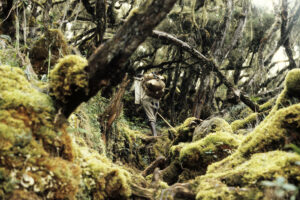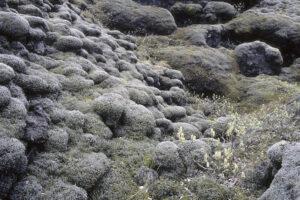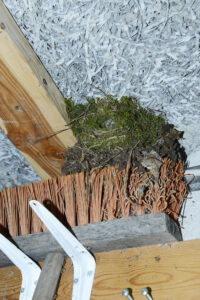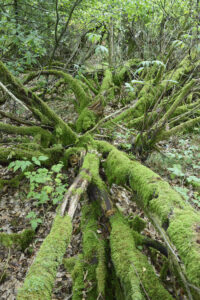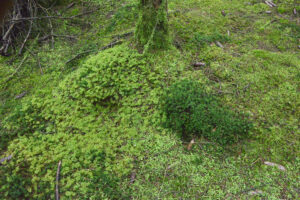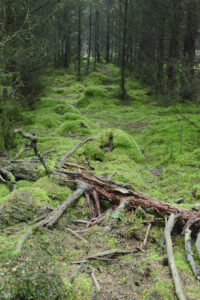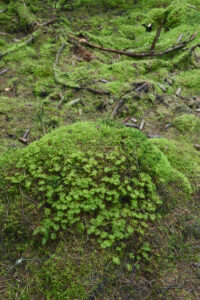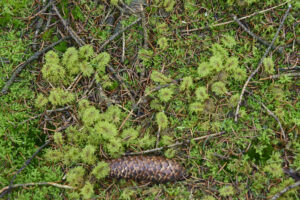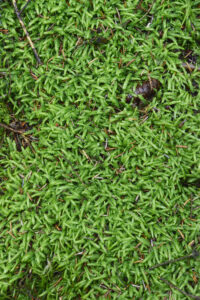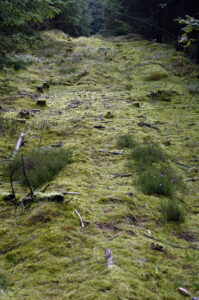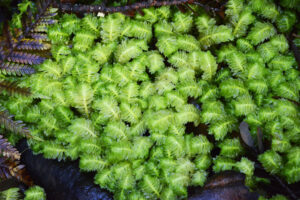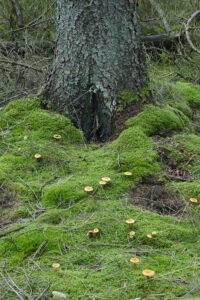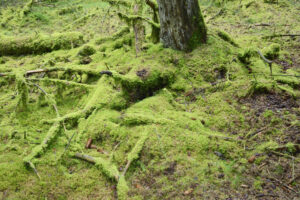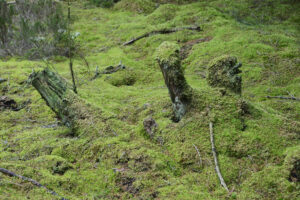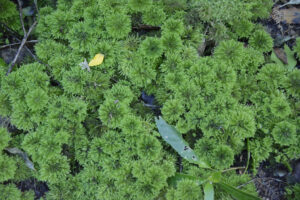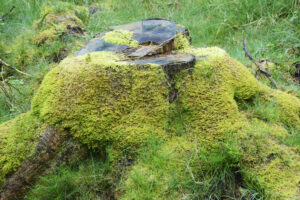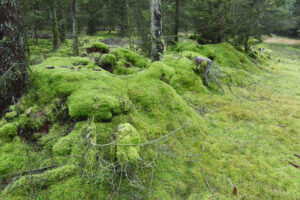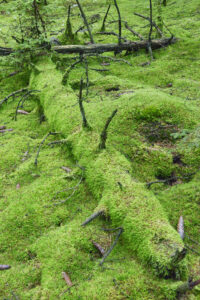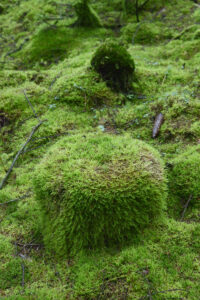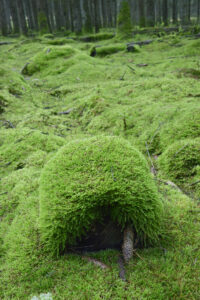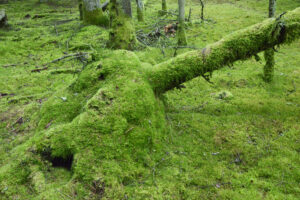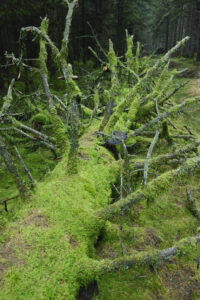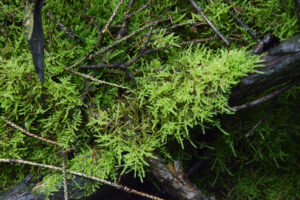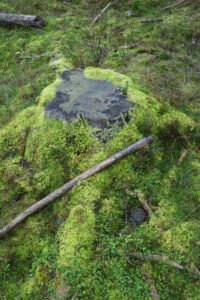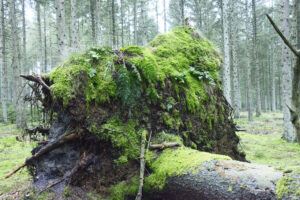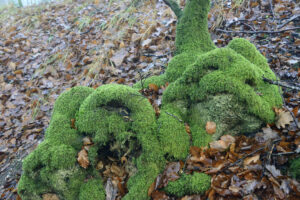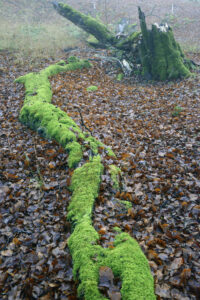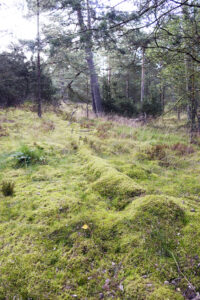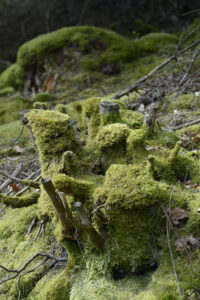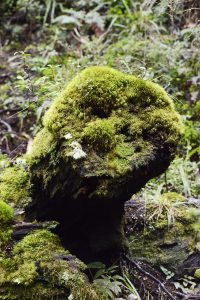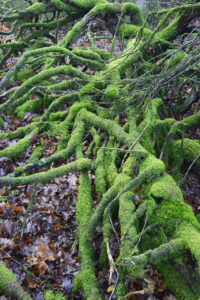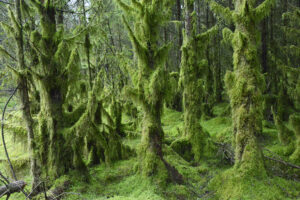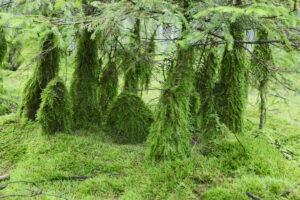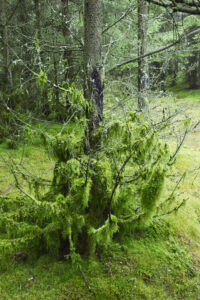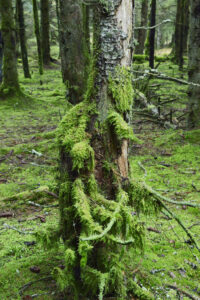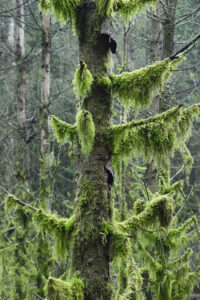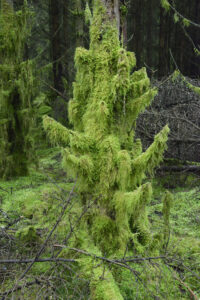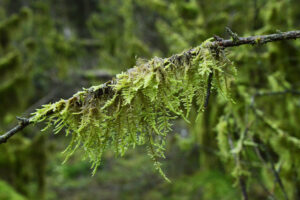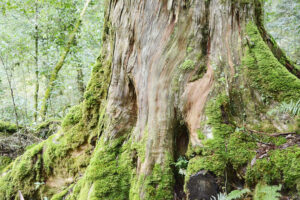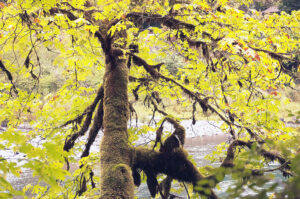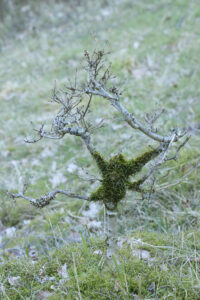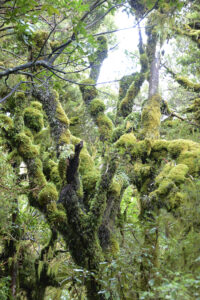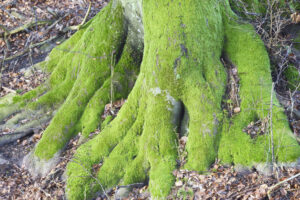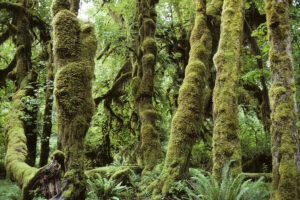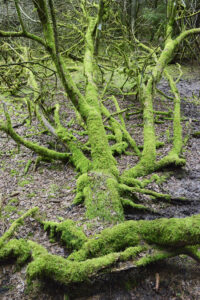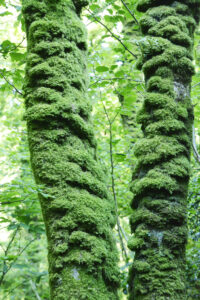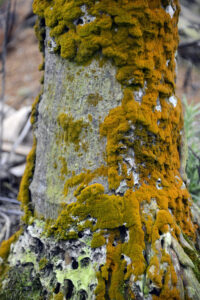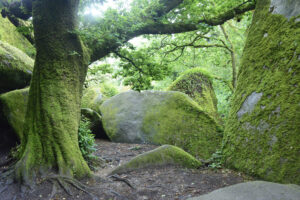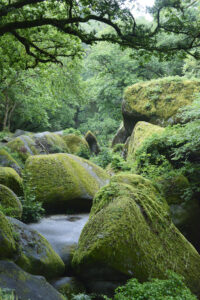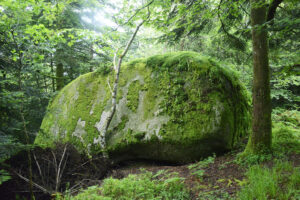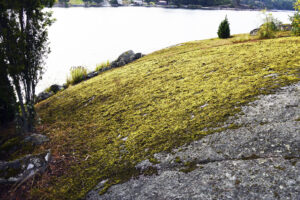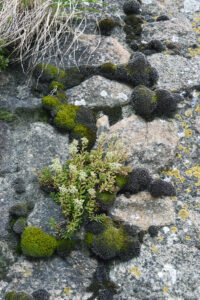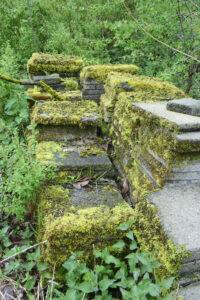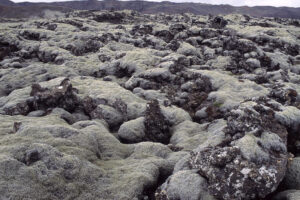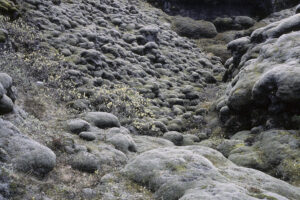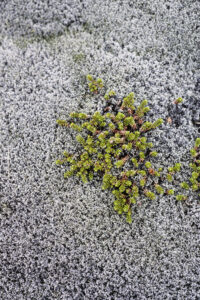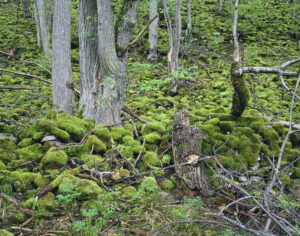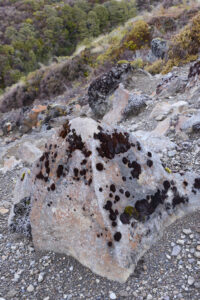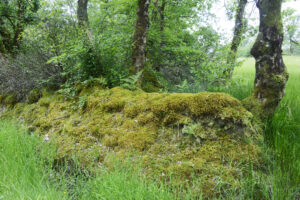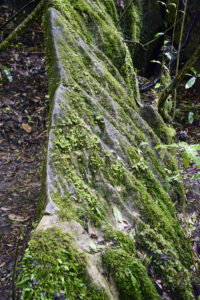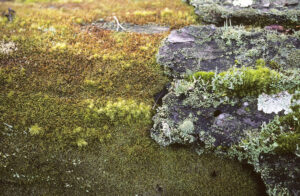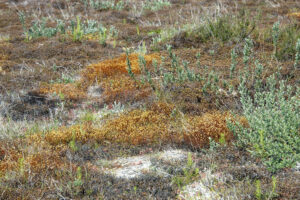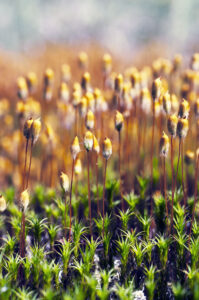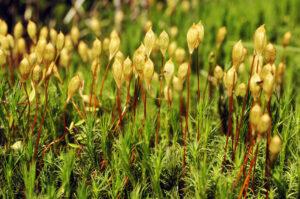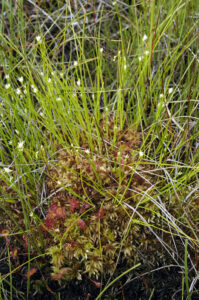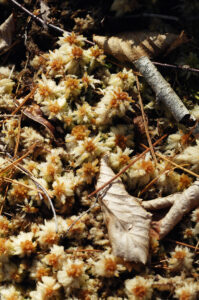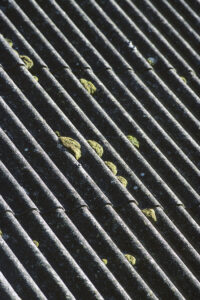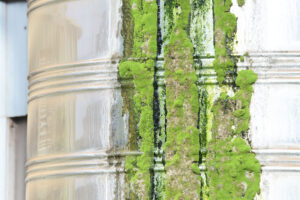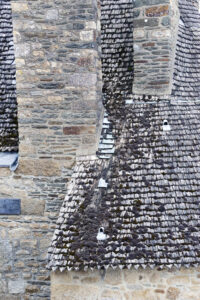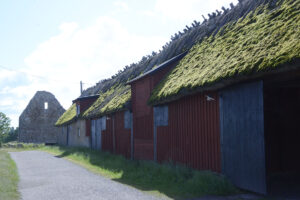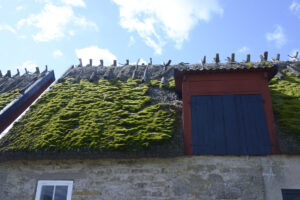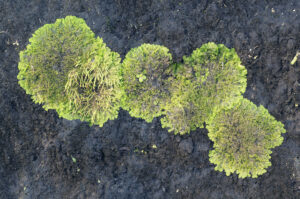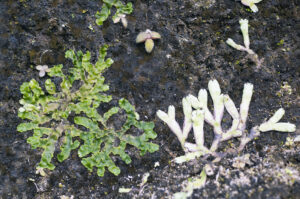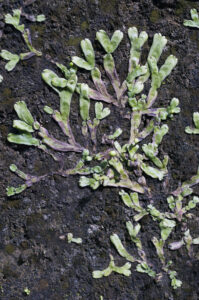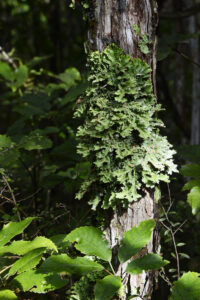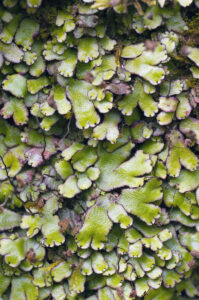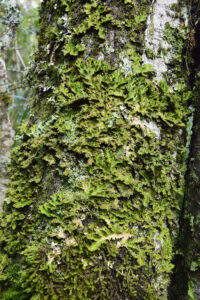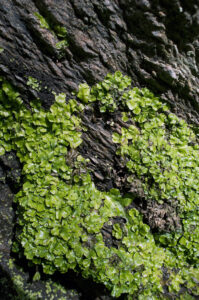Mosses
Moss-covered tree trunks, Velling Skov, Jutland, Denmark. (Photo copyright © by Kaj Halberg)
Moss-covered trail in a forest of a species of heather, Erica kingaensis, whose branches are draped with old-man’s-beard lichens (Usnea), Ruwenzori National Park, Zaire. (Photo copyright © by Kaj Halberg)
Lava boulders, covered in cushions of the moss species Racomitrium lanuginosum, Brunahraun, southern Iceland. In Icelandic, hraun means ‘lava’. Woolly willow (Salix lanata) is also present. (Photo copyright © by Kaj Halberg)
This nest of winter wren (Troglodytes troglodytes), which mainly consists of moss, has been built on an upside-down broom, eastern Jutland, Denmark. (Photo copyright © by Kaj Halberg)
An old overturned juniper (Juniperus communis), overgrown by mosses, Salten Langsø, Jutland, Denmark. (Photo copyright © by Kaj Halberg)
Mosses on forest floors
Gludsted Plantation, central Jutland, Denmark, was established between 1877 and 1900. Many parts of this plantation are now so old that the forest floor and overturned trees are completely covered by large moss cushions.
(Photos copyright © by Kaj Halberg)
Moss-clad forest path, Rævsø (‘Fox Lake’), Jutland, Denmark. Flowering cross-leaved heath (Erica tetralix) grows along the path. (Photo copyright © by Kaj Halberg)
Moss on the forest floor, Waipoua Forest, New Zealand. (Photo copyright © by Kaj Halberg)
Moss-covered forest floor with false chanterelles (Hygrophoropsis aurantiaca), Nørlund Plantation, Jutland, Denmark. This species is described on the page In praise of the colour orange. (Photo copyright © by Kaj Halberg)
Fallen branches, covered in mosses, Store Hjøllund Plantation, Jutland, Denmark. (Photo copyright © by Kaj Halberg)
Moss-covered forest floor with spruce stumps, Søby, central Jutland, Denmark. (Photo copyright © by Kaj Halberg)
Umbrella mosses (Hypopterygium) is a genus in the family Hypopterygiaceae, characterized by a creeping stem, having erect branches with a terminal, almost circular umbrella-like leaf with pinnate branches.
These plants grow on humid forest floors and other wetter areas, found in Europe, Asia, Africa, the Americas, Indian Ocean Islands, Pacific Islands, Australia, and New Zealand. The number of species is disputed. Some authorities claim that there are only 7 species worldwide, others say about 28.
A species of umbrella moss, Lake Tikitapu, New Zealand. (Photo copyright © by Kaj Halberg)
Mosses on tree stumps and toppled trees
Moss-covered spruce stump, Store Hjøllund Plantation, central Jutland, Denmark. (Foto copyright © by Kaj Halberg)
These pictures are from Gludsted Plantation, Denmark (described above). (Photos copyright © by Kaj Halberg)
Roots of an overturned spruce with mosses and broad buckler fern (Dryopteris dilatata), Gludsted Plantation. (Photo copyright © by Kaj Halberg)
Moss-covered tree trunks, Velling Skov, Jutland, Denmark. (Photos copyright © by Kaj Halberg)
In a forest, growing on sand dunes in Hagestad Nature Reserve, Skåne, Sweden, this fallen trunk of Scots pine (Pinus sylvestris) has been overgrown by mosses and heather (Calluna vulgaris). Scots pine is described on the page Plants: Ancient and huge trees. (Photo copyright © by Kaj Halberg)
Spruce stump, covered in mosses, Ry, central Jutland, Denmark. (Photo copyright © by Kaj Halberg)
These young Norway spruces (Picea abies) have sprouted on a moss-covered tree stump, Store Hjøllund Plantation, central Jutland, Denmark. This species is described on the page Plants: Ancient and huge trees. (Photo copyright © by Kaj Halberg)
This moss-covered tree stump resembles a snarling monster, Tongariro National Park, New Zealand. (Photo copyright © by Kaj Halberg)
Roots of an old overturned juniper (Juniperus communis), overgrown by mosses, Bryrup Langsø, Jutland, Denmark. This species is described on the page Plants: Plants in folklore and poetry. (Photo copyright © by Kaj Halberg)
Mosses on living trees
Spruce trees with growths of mosses, Gludsted Plantation, Denmark (described above). (Photos copyright © by Kaj Halberg)
Moss cushions on the trunk of an old Taiwan red cypress (Chamaecyparis formosana), Dasyueshan National Forest, central Taiwan. This species is described on the page Plants: Ancient and huge trees. (Photo copyright © by Kaj Halberg)
An old tree with moss cushions, in which grow navelwort (Umbilicus rupestris) and Herb Robert (Geranium robertianum), between Mont St. Michel and Dinan, Brittany. (Photo copyright © by Kaj Halberg)
Gorgeous yellow autumn foliage on a large, moss-covered bigleaf maple (Acer macrophyllum), Umpqua National Forest, Oregon, United States. (Photo copyright © by Kaj Halberg)
This moss, growing on a young common oak (Quercus robur), Palsgård Skov, central Jutland, Denmark, resembles a hairy gorilla. (Photo copyright © by Kaj Halberg)
Moss-covered tree in a temperate rainforest, Dawson Falls, Mt. Taranaki, New Zealand. (Photo copyright © by Kaj Halberg)
Trunk of an old beech (Fagus sylvatica), covered in mosses, Ry, central Jutland, Denmark. The beech is described on the page Plants: Ancient and huge trees. (Photo copyright © by Kaj Halberg)
Moss, creating a pattern on the trunk of a tree fern, Trouson Kauri Park, New Zealand. (Photo copyright © by Kaj Halberg)
Moss-covered western hemlocks (Tsuga heterophylla), growing in a row on a fallen log, a so-called nursery log, Hoh Forest, Olympic National Park, Washington State. (Photo copyright © by Kaj Halberg)
Moss-covered goat willow (Salix caprea), Store Hjøllund Plantation, central Jutland, Denmark. This species is described on the page Plants: Ancient and huge trees. (Photo copyright © by Kaj Halberg)
Moss cushions on trees, Stangala Valley, Brittany. (Photo copyright © by Kaj Halberg)
Trunk of a betel palm (Areca catechu) with moss cushions, Beishan, near Puli, Taiwan. This species is described on the page Nature: Nature’s patterns. (Photo copyright © by Kaj Halberg)
Mosses on stones and stone fences
Moss-covered boulders, Huelgoat, Brittany. (Photos copyright © by Kaj Halberg)
Stone fence, covered in moss cushions, Funen, Denmark. (Photo copyright © by Kaj Halberg)
Moss-covered rock, Järnaviken, Blekinge, Sweden. (Photo copyright © by Kaj Halberg)
An old wall with moss cushions and white stonecrop (Sedum album), Mont St. Michel, Brittany. (Photo copyright © by Kaj Halberg)
It seems that these tiles near Lake Hampen, Jutland, Denmark, have been ‘forgotten’, and they are now covered in mosses. (Photo copyright © by Kaj Halberg)
Stone fence, covered in mosses, Stangala Valley, Brittany. (Photo copyright © by Kaj Halberg)
Racomitrium lanuginosum is very widely distributed in arctic and subarctic areas in the Northern Hemisphere, in montane areas spread around the globe, and on many islands in the Atlantic and Pacific Oceans. It mainly grows on acidic boulders, but may also be found in tundra or marshes.
Lava boulders, covered in cushions of Racomitrium lanuginosum, Ögmundarhraun (top), and Brunahraun, both in southern Iceland. In Icelandic, hraun means ‘lava’. Woolly willow (Salix lanata) is present in the centre picture, and crowberry (Empetrum nigrum) in the bottom picture. (Photos copyright © by Kaj Halberg)
Stone fence, overgrown by mosses, Borgholm, Öland, Sweden. (Photo copyright © by Kaj Halberg)
Dark moss on a rock, Tongariro National Park, New Zealand. (Photo copyright © by Kaj Halberg)
Stone fence, covered in moss cushions, Reserve Naturelle Tourbiere du Venec, Brittany. (Photo copyright © by Kaj Halberg)
Rock with various mosses, including a species of umbrella moss (see Hypopterygium above), Mangapohue River Gorge, New Zealand. (Photo copyright © by Kaj Halberg)
Rock, covered in mosses and lichens, Connetquot River State Park, Long Island, New York State. (Photo copyright © by Kaj Halberg)
Stone fence, covered in moss cushions, Halltorps Hage, Öland, Sweden. (Photo copyright © by Kaj Halberg)
Mosses in heaths and dunes
Moss cushions, cracked due to drought, Harrild Hede, central Jutland, Denmark. (Photo copyright © by Kaj Halberg)
Mosses, growing on a sand dune, Dueodde, Bornholm, Denmark. The shrubs are creeping willow (Salix repens). (Photo copyright © by Kaj Halberg)
Mosses in swamps
Common haircap moss (Polytrichum commune) is a common species that is partial to wet areas, including marshes, humid heathland, and along forest streams. It is mostly below 10 cm tall, but may often reach 30 cm, and under exceptional conditions even 70 cm. It is widely distributed in the Northern Hemisphere, and is also found on several Pacific Islands, and in Australia, New Zealand, and Mexico.
Large cushions of common haircap moss, Lyngsø, Silkeborg, Denmark. (Photo copyright © by Kaj Halberg)
Wet marsh with birches (Betula) and common haircap moss, near Gjessø, Jutland, Denmark. (Photos copyright © by Kaj Halberg)
Common haircap moss with sporangies, Almindingen, Bornholm (top), and Fanø, both in Denmark. (Photos copyright © by Kaj Halberg)
Moss-covered tussocks in a swamp, Borresø, central Jutland, Denmark. (Photo copyright © by Kaj Halberg)
Bog mosses (Sphagnum) are a genus with about 380 species, which are able to store large quantities of water in their cells, both living and dead plants. Some species may hold up to 26 times as much water as their dry weight, an adaptation that helps the plant to withstand long periods of drought. Over time, bog mosses may form large mires, called raised bogs.
A species of bog moss with white beak-sedge (Rhynchospora alba) and round-leaved sundew (Drosera rotundifolia), central Jutland, Denmark. Sundew species are described on the page Plants: Carnivorous plants. (Photo copyright © by Kaj Halberg)
A species of bog moss, Wells National Estuarine Reserve, Maine, United States. (Photo copyright © by Kaj Halberg)
Mosses on buildings
Moss, growing on a roof, Jutland, Denmark. (Photo copyright © by Kaj Halberg)
Moss and green algae on a leaking water tank, Taichung, Taiwan. (Photo copyright © by Kaj Halberg)
Dark moss cushions on house roofs, Mont St. Michel, Brittany. (Photo copyright © by Kaj Halberg)
Farm house with moss on the roof, located near the ruins of the Iron Age castle Gråborg, Öland, Sweden. In the upper picture, ruins of Sankt Knuts Kapell (‘Saint Canute’s Chapel’), erected in the 1100s, are seen in the background. This chapel is described on the page Religion: Christianity. (Photos copyright © by Kaj Halberg)
Moss and withered leaves on a house roof, Dasyueshan National Forest, central Taiwan. (Photo copyright © by Kaj Halberg)
Liverworts
These plants, sometimes called liver mosses, constitute about 9000 species in the division Marchantiophyta. They are not mosses, but resemble them in a number of ways, for example by having green foliage, by being completely dependent on humid surroundings, and by multiplying by spores. Liverworts are found on almost the entire planet.
Liverworts, El Castillo, Cordillera de Tilarán, Costa Rica. (Photos copyright © by Kaj Halberg)
Liverwort, Tongariro National Park, New Zealand. (Photo copyright © by Kaj Halberg)
Liverwort, Mingtsih, Taiwan. (Photo copyright © by Kaj Halberg)
Liverwort, Jubilee Park, Ohakune, New Zealand. (Photo copyright © by Kaj Halberg)
Conocephalum is the only genus in the family Conocephalaceae, comprising at least 6 species. They are rather large liverworts with distinct patterns on the leaves, resembling snakeskin, giving rise to the popular name snakeskin liverworts.
These plants are relatively common and widely distributed throughout North America, Europe, and East Asia, mostly growing in moist and shaded habitats, including wet rocks and cliffs. Some species may be found in open woodlands or on sandy banks.
Scented liverwort (Conocephalum conicum), growing on rock walls, Døndalen (top) and Læså, both Bornholm, Denmark. (Photos copyright © by Kaj Halberg)
(Uploaded February 2023)
(Latest update October 2024)

